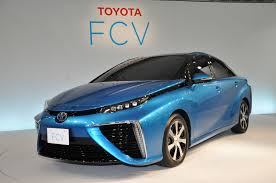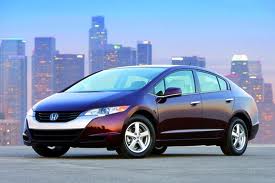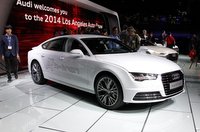The Car of the Future Shows Up Again
Last year it was two concept vehicles and one surprise — a fuel cell vehicle going on sale sooner than anyone expected. This year (2014 LA Auto Show) one was one fuel cell is already on sale (albeit in small numbers), two are about to hit the market and two surprise concepts debuted at the show. Add in the buzz about California’s hydrogen-station-building frenzy and the fuel cell zero emission vehicle was back in the news again.

For years derided as the future technology that was always 20 years in the future, hydrogen fuel cells appear to be making a serious run at becoming a relevant alternative to the internal combustion engine and the 2014 LA Auto Show. Here’s a run-down of the news.
- Hyundai is celebrating the end of its first calendar year of TucsonFCEV sales. The numbers are still low as even with tens of thousands of web-based “handraisers,” converting that interest into sales is challenging because of the lack of infrastructure. The deal for those close to the few existing stations remains as much of a no-brainer as some of the low-lease EV ones—$499/month for a three-year lease with $2,999 down and all fuel and maintenance included.

There are Honda Clarity fuel cell vehicles already on the road - Toyota made a big splash with journalists around the show (though not with a press conference at the show), introducing the production version of its coming Mirai sedan. We first saw the sedan in the flesh a few months ago and recognize what Toyota is up to. As they did with the Prius, the intent is to present a distinctive vehicle that will give owners immediate recognition. The Mirai (“future” in Japanese) is no Camry when it comes to styling, so the early adopters and techies who grab one with be spending a lot of time answering questions about their unique vehicle when it goes on sale in 2015. Pricing was also announced–$57,500, pretty expensive for a Toyota, but the company is matching Hyundai’s $499/month lease deal. Toyota also made it clear that that the next generation’s hydrogen-powered drivetrain (due around 2020) would be between one-third and one-fourth the cost of this one (and as a metric the company told Automotive News the current fuel cell system is one-twentieth the cost of the previous generation vehicle, which first debuted in 2008). Battery prognosticators should take note. The cost reduction curve typically doesn’t accelerate, but slows down over time. Not surprisingly, it’s the 2020 timeframe when Toyota expects to ramp up production from the hundreds planned for the current Mirai to “tens of thousands.”
- Honda also went outside the LA show, showcasing its production fuel cell sedan to media in Japan the same week (and promising to bring it to Detroit next month). Like Toyota, Honda will present a car unlikely to be mistaken for the new Accord when it hits the market in 2016. It features futuristic styling reminiscent of the original Insight, but in a larger scale. Honda’s launch date was moved back from earlier estimates, but Honda underscored its commitment to make a full-court press on FCEVs, touting progress on the fuel-cell stock that has 60 percent more power packed in a one-third smaller package than the previous generation. Honda also announced it was loaning money to one of the builders of the growing hydrogen station network to expand the number of stations that would be built.
- Surprising everyone at the show was Audi, which normally talks about its efficient gasoline and diesel powerplants while promising plug-ins in the near future. The company unveiled an A7 H-tron, a fuel cell model that also had an 8.8-kWh battery pack capable of providing its own launch power prior to the fuel cell kicking in. Audi’s point was that true performance was possible in a fuel cell with the set-up providing power to all four wheels through front and rear electric motors.
-

An LA hydrogen surprise from Audi - Volkswagen added its own surprise (of course the parent company of Audi and VW is the same so there was undoubtedly some common technology involved) when it unveiled a hydrogen version of the new Golf Sportwagen. The HyMotion concept borrows its electric motor from the just-introduced e-Golf and uses a lithium-ion battery pack from the Jetta Hybrid. VW’s fielded fuel cell cars before, but they were built on a small SUV platform. The smaller package demonstrates some of the advances in packaging VW has made with the technology.
- The news that undergirds all of the automakers optimism about fuel cell technology, at least in California, is the state’s dedication of $20 million per year to fund the construction of a 100-station fueling infrastructure during the next decade. Legislation passed and signed by Gov. Brown dedicated that amount as a minimum investment by the state to help jump start the construction and running of hydrogen stations in the early years when there may not be enough vehicles to make the business viable. The state’s Energy Commission has contracts out and expects to have more than 50 stations operating by the end of 2015. One–third of the hydrogen supplied in the state is mandated to come from renewable sources. Fuel cell car buyers will be eligible for substantial financial incentives from the state and federal government tax credits. Estimates the state gathered from automakers are that there will be 18,500 FCEVs in California by 2020.
-

Honda FCEV sketch A couple weeks after the show Hyundai’s fuel cell “engine” was named to WardsAuto World’s 10 Best Engines of 2015. The propulsion unit was singled out as the editors said for “slipping the most advanced automotive technology imaginable into a roomy family vehicle and making it all very consumer friendly.”
The fuel cell news wasn’t a clarion call, especially among all of the low-volume, high-end models several automakers were touting at the 2014 LA Auto Show, but it was significant for that segment of the green market. One clear signal is that the pricing of fuel cell cars appears to be following the track of battery electrics, where a monthly lease rate becomes the standard for most of cars in the segment. Second to that is the solid commitment from major automakers (so far without the whining about losing money on each car they sell or limiting production to the numbers required to meet California ZEV requirements) appears unchanged. All of the major automakers either have their own fuel cell program or are part of a group of companies pursuing the technology.
Here’s how the companies have paired up to bring fuel cell cars to market by sharing development costs and gain some economies of scale before true mass production.
- Toyota and BMW are working together.
- Honda and GM have a working relationship.
- Daimler, Ford and Nissan have an alliance.
- VW and Hyundai appear to be going it alone.
- Of the big guys, Fiat Chrysler may be the odd man out with no announced programs or alliances.

Akio Toyoda, Toyota Motor’s president and the latest successor from the auto company’s founding family, told Bloomberg Businessweek that “there’s room for both plug-in electrics and hydrogen cars.” He dismisses doubters: “Fifteen years ago they said the same thing about the Prius. Since, then…we have sold seven million (total hybrids) of them.”
Skepticism about the ultimate success of fuel cells in the market remains, but expect the push forward is going to get stronger in 2015. As John Addison showed in his review of the plug-in models available at the show, a strong “green” undercurrent is flowing in the automotive market. The hydrogen wave appears to be just beginning to crest.
Related stories you might enjoy:
2014 LA Auto Show: Plug-in Hybrids, Best Bet
Hydrogen Fuel Cell Cars Go On Sale in 2014!
Suddenly, Hydrogen Fuel Cell Cars Are Back

0 thoughts on “2014 LA Auto Show: A Hydrogen Milestone”